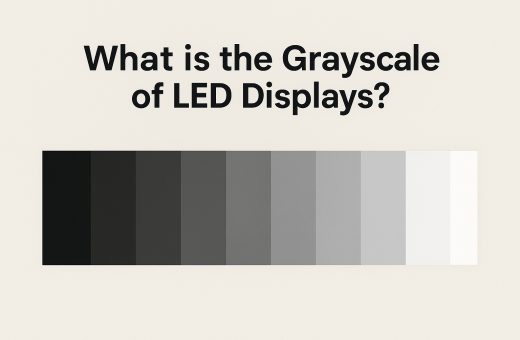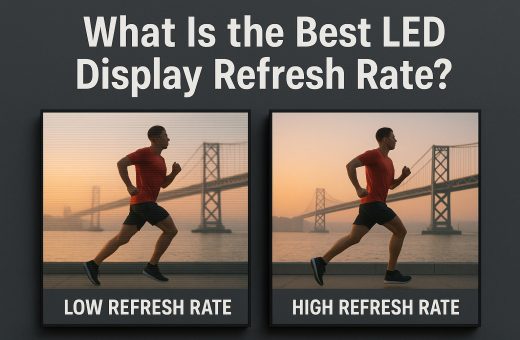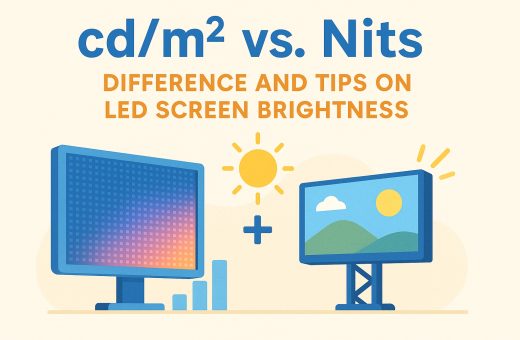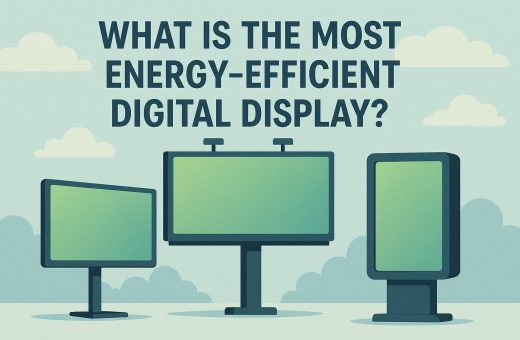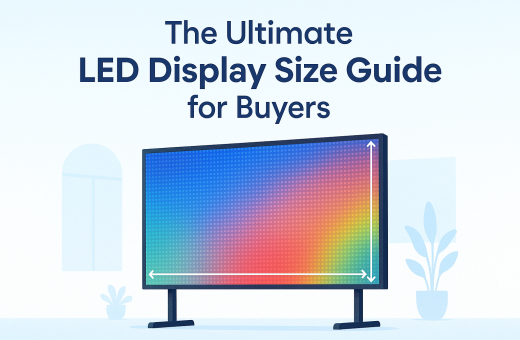Table of Contents
Outdoor LED signage is widely used across retail, public institutions, transportation hubs, and many other sectors. Despite its growing presence, buyers often make critical mistakes that go unnoticed until after installation, leading to reduced performance, increased long-term costs, or early system failure.
This article identifies five common pitfalls in selecting and deploying outdoor LED signage and provides clear guidance to help buyers avoid costly errors and choose a solution that performs reliably over time.
Pitfall 1: Prioritizing Price Over Performance
It is a common practice to go for cheap outdoor LED signage. Without reviewing the technical specifications, you may suffer from the risk of low visual performance. This approach may seem cost-effective initially but often results in displays that are not suited for harsh outdoor environments.
It results in poor signage visibility under sunlight, unstable video playback, and unreadable content at typical viewing distances.
The solution is quite straightforward: to define clear technical thresholds before making any selection. The display should deliver brightness above 5,000 nits to remain visible outdoors. A refresh rate of at least 1920 hertz is required to prevent flicker. Pixel pitch must align with the expected viewing distance to ensure legibility. Prioritize standards, clarify the bottom line. It protects the long-term value of your investment.
Pitfall 2: Ignoring Installation Site Constraints
What suits you is the best. Selecting outdoor digital display screens without evaluating the technical realities of the installation site results in a waste of time and money. This oversight creates serious mismatches between the chosen product and the conditions in which it must operate.
Some common errors include:
- Selecting a screen size that exceeds the physical space
- Placing the display where nearby objects obstruct visibility
- Ignoring factors such as sunlight direction, surface material, and power access
These misjudgments result in poor performance, higher installation costs, or the need to modify the structure after purchase.
That is why it is always recommended to conduct on-site technical surveys before finalizing any model or display size. This survey must assess dimensions, angles of visibility, environmental exposure, structural capacity, cable routing, and local lighting conditions.
Pitfall 3: Overlooking Environmental Durability
Outdoor LED signage displays must endure continuous exposure to sunlight, rain, dust, and temperature changes. Many buyers fail to evaluate whether the product is engineered to handle these conditions over time.
Ignoring these risks can result in internal moisture damage, fading caused by ultraviolet radiation, electrical failure due to dust intrusion, and complete system breakdown in extreme climates. These failures reduce performance, shorten service life, and increase long-term replacement costs.
To avoid this, it is important to verify critical environmental protection standards before purchase. The display should have a minimum rating of IP65 to block water and dust. Panels must be ultraviolet-resistant to maintain visual quality under sunlight. Operating temperature range, waterproof enclosures, sealed power supplies, and adequate thermal management should also be confirmed to ensure stable outdoor operation in the intended location.
Pitfall 4: Weak After-Sales and Spare Parts Support
Some buyers approve the purchase without confirming the vendor’s ability to provide timely technical support and component replacement. An unresolved controller fault or dead module can leave the outdoor LED signage display inactive for extended periods without local technician support.
If you come across a vendor that lacks a defined service structure or avoids committing to clear repair timelines, it is a clear red flag. Limited technician availability, poor communication, or a lack of spare parts can leave the display out of operation for long periods. This results in lost screen time, reduced visibility, and unexpected maintenance costs.
To prevent this, buyers must ask detailed questions about after-sales support before making a purchase. The supplier should provide a written Service Level Agreement that outlines response time, repair procedures, and escalation steps. The supplier must also confirm the frequency of on-site maintenance and demonstrate that critical spare parts are stocked within the region. These elements determine whether the system remains functional over time or becomes a burden during technical failure.
Pitfall 5: Vague Contracts and Poor Communication
Some buyers finalize the purchase without reviewing the contract in detail. It is possible that the contract misses important terms related to technical specifications, responsibilities, and delivery schedules, which can lead to unnecessary complications later on.
A common issue is the lack of a defined scope. The contract may not specify resolution, pixel pitch, brightness level, control system, or installation requirements. Communication is also unclear when you sign vague contracts.
In order to avoid this, you must know the complete project scope before signing. The scope must define all technical specifications, installation procedures, and testing requirements. A communication plan should also be established, with designated contacts, reporting timelines, and written confirmation protocols. These steps prevent confusion and keep the project aligned with the original agreement.
Read More: How to Choose an Outdoor LED Display Board (2025 Buying Guide)
Chainzone Outdoor LED Displays Are Really for Your Projects
Chainzone brings a range of outdoor displays built to perform in demanding environments. Products like the V-Plus Series deliver brightness levels exceeding ten thousand nits and ultra-high refresh rates, making them suitable for large-format commercial applications, like DOOH (digital-out-of-home).
We serve clients in more than 120 countries, with technology trusted in both public infrastructure and commercial projects worldwide. Our commitment to engineering quality and long-term reliability continues to set us apart in a highly competitive industry and makes our outdoor digital signage for businesses a reliable solution.
Wrapping-Up
Avoiding the common mistakes while purchasing outdoor LED signage can make a significant difference in the long-term performance and reliability of your outdoor LED signage. Chainzone comes with successful cases, proven product quality, and strong technical support. With a global presence and decades of experience, Chainzone is well-positioned to support your next signage project with confidence.



